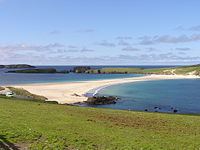Gaelic name Unknown Meaning of name na Area rank na Island groups Shetland, British Isles | Norse name Unknown OS grid reference HU365210 Highest elevation 53 m Lieutenancy area Shetland | |
 | ||
Sundown at st ninian s isle shetland
St Ninian's Isle is a small tied island connected by the largest tombolo in the UK to the south-western coast of the Mainland, Shetland, in Scotland. The tombolo, known locally as an ayre from the Old Norse for "gravel bank", is 500 metres long. During the summer the tombolo is above sea level and accessible to walkers. During winter, stronger wave action removes sand from the beach so that it is usually covered at high tide, and occasionally throughout the tidal cycle, until the sand is returned the following spring. Depending on the definition used, St. Ninian's is thus either an island, or a peninsula; it has an area of about 72 hectares. The nearest settlement is Bigton in the parish of Dunrossness on the South Mainland. The important early medieval St Ninian's Isle Treasure of metalwork, mostly in silver, was discovered under the church floor in 1958. Many seabirds, including puffins, visit the island, with several species nesting there.
Contents
- Sundown at st ninian s isle shetland
- Map of St Ninians Isle United Kingdom
- History
- St Ninians Isle Treasure
- References
Map of St Ninians Isle, United Kingdom
History
As its name suggests, the island has ecclesiastical connections, which may like others in the Northern Isles, Hebrides and Faroes have connections to the Culdees or papar. However, the island's history is far older than Christianity, and Neolithic graves have been found within the walls of the chapel (formerly beneath the floor).
The ruins of a 12th-century chapel can still be seen near the end of the tombolo. The dedication is to Shetland's patron saint, the enigmatic Saint Ninian of Galloway, who is also widely venerated on the nearby Orkney Islands, and may be commemorated in the name of North Ronaldsay. In 1958, an excavation found a hoard of 8th century silver in the chapel grounds under a stone slab in a wooden box, which caused a renewed archaeological interest in the island. It was suspected to have been buried to hide it from, or stolen in, a Viking raid. The remains of a pre-Norse chapel were also found, which may indicate some kind of Culdee presence.
The last family to live on the island, that of Henry Leask, left the island in 1796. Henry Leask was married twice and had 13 children.
St Ninian's Isle Treasure
The St Ninian's Isle Treasure was discovered under a cross-marked slab in the floor of the early St. Ninian's church, on 4 July 1958 by a local schoolboy, Douglas Coutts. Coutts was helping visiting archaeologists led by Professor A. C. O'Dell of Aberdeen University at a dig on the isle. The silver bowls, jewellery and other pieces are believed to date from approx. 800 AD.
Professor O'Dell, writing in December 1959 in Antiquity magazine, recounts that:
The treasure is the best survival of Scottish silver metalwork from the period, some pieces gilded. As Prof. O'Dell says, there were pieces for secular use such as a series of different penannular brooches (some of them probably as unfinished half-ware) and different chapes from sword scabbards, pieces which might have been used for religious ceremonies and rituals like the bowls, spoons, and "thimbles" and all of those joined with some pieces of unsure meanings like the heavy ring chains or collars which are referred to as "power symbols of Pictish chieftains" by some scholars. The brooches show a variety of typical Pictish forms, with both animal-head and lobed geometrical forms of terminal. Two of the scabbard chapes and a sword pommel appear to be Anglo-Saxon pieces, probably made in Mercia in the late 8th century; one has an inscription with a prayer in Old English. One of the mounts has a triple spiral design. We know of exchanges of gifts between Anglo-Saxon and Pictish rulers, and generally "weapons are among the objects which travelled most widely in the early medieval period".
The treasure was donated to the National Museum of Antiquities of Scotland (NMAS) in 1965-6 and is currently in the Museum of Scotland in Edinburgh, whilst replicas are held by the Shetland Museum.
